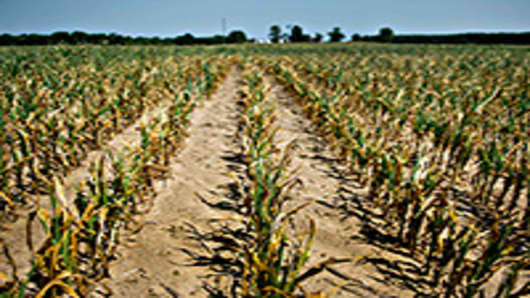The worst drought in more than 50 years in the U.S. is hurting food companies in China and margins are likely to suffer in the second half of the year, even as firms battle rising wages, analysts tell CNBC.
Tingyi , one of the world’s largest producers of instant noodles, and United President, the biggest food-production company in Asia, should see margins decline over the next few months as prices of raw ingredients such as corn to soybeans rise, analysts say.
“The drought that we are having in the U.S. is raising corn and soybean prices dramatically, that hasn’t yet hit the food chain but when that hits the food chain, they (food companies) are going to see food costs go through the roof,” Donald Krueger, Senior Analyst for Equity Research at Motley Fool Asset Management, told CNBC Asia’s“The Call”.
There are some signs that China may already be seeing its first casualty of higher food prices.
On Wednesday, Yum Brands, the biggest U.S. food company operating in China, reported second-quarter profit that missed Wall Street's view as inflation in China, where it earns 40 percent of its revenue, cut into margins there.
The U.S. is the world’s biggest producer of corn, growing about a third of the total crop, and any supply shortage there will drive global prices sharply higher. The commodity, which has already risen 30 percent since the beginning of June, is approaching record highs. December corn futures, representing the crop currently in the field, rose marginally on Wednesday to $7.73 a bushel, just 3.4 percent lower than the record $7.99 per bushel reached last June.
More than 61 percent of the U.S. is now considered drought-stricken, the highest percentage in the 12-year history of the U.S. Drought Monitor.
Soybeans hit an all-time high on Wednesday, with the contract for August delivery rising 44.5 cents, or 2.7 percent, to finish at $16.835 per bushel. Wheat prices also ended at the highest level since the spring of 2008.
All this points to higher food prices in China in the second half of the year, analysts say. Jessie Guo, Head of Consumer Research at Jefferies in Hong Kong, said the high prices of soybean, which is an ingredient of many food products in China, will also lead to higher prices for other products like beef and pork.
“Soybean is very important for people who raise cattle as it goes into the feed, and that will add some pricing pressure on food prices in general in the second half of the year,” Guo told CNBC.
Labor Costs Rising
At the same time, labor costs in China are rising across the board, with wages increasing more than 10 percent a year for workers in the agricultural, retail and food industries, Guo said.
“I would see an accelerated increase across the board and this will impact margins,” she added.
Yum blamed rising food and wage costs as well as expenses related to extending operating hours and building new restaurants in the country for cutting into margins.
Some observers, however, are not as pessimistic on food inflation . Donna Kwok, China Economist at HSBC in Hong Kong, expects prices to decline in the second half of the year and corporate margins to improve.
“While food prices were a key driver of China's inflation last year, the bulk of it related to supply issues at home, not overseas,” Kwok said. “China’s imported food as a percentage of domestic consumption is only around 3 percent. This means that while a drought in the U.S. would for sure put marginal upward pressure on prices in China, the impact would be significantly less than if there was a drought in China.”
China's annual consumer inflation cooled to 2.2 percent in June, from May's 3.0 percent, official data showed earlier this month.
— By CNBC’s Jean Chua.


